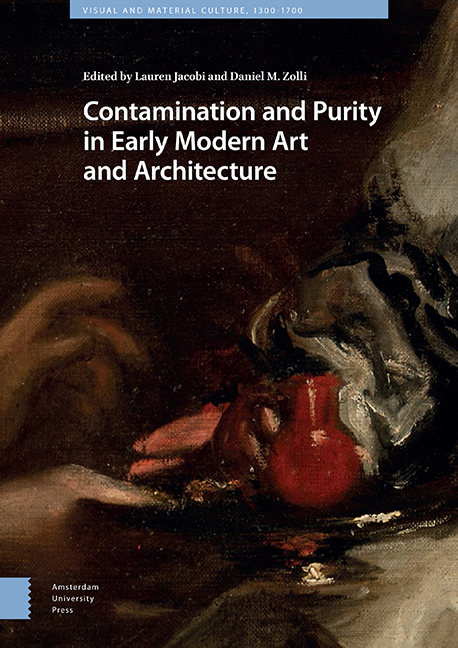Book contents
- Frontmatter
- Contents
- List of Illustrations
- Introduction: Contamination and Purity in Early Modern Art and Architecture
- 1 Generation and Ruination in the Display of Michelangelo’s Non-finito
- 2 The Sacrilege of Soot: Liturgical Decorum and the Black Madonna of Loreto
- 3 Sedimentary Aesthetics
- 4 ‘Adding to the Good Silver with Other Trickery’ : Purity and Contamination in Clement VII’s Emergency Currency
- 5 Tapestry as Tainted Medium: Charles V’s Conquest of Tunis
- 6 Bruegel’s Dirty Little Atoms
- 7 Leakage, Contagion, and Containment in Early Modern Venice
- 8 Contamination, Purification, Determinism: The Italian Pontine Marshes
- 9 Colonial Consecrations, Violent Reclamations, and Contested Spaces in the Spanish Americas
- 10 Contamination | Purification
- Index
5 - Tapestry as Tainted Medium: Charles V’s Conquest of Tunis
Published online by Cambridge University Press: 27 May 2021
- Frontmatter
- Contents
- List of Illustrations
- Introduction: Contamination and Purity in Early Modern Art and Architecture
- 1 Generation and Ruination in the Display of Michelangelo’s Non-finito
- 2 The Sacrilege of Soot: Liturgical Decorum and the Black Madonna of Loreto
- 3 Sedimentary Aesthetics
- 4 ‘Adding to the Good Silver with Other Trickery’ : Purity and Contamination in Clement VII’s Emergency Currency
- 5 Tapestry as Tainted Medium: Charles V’s Conquest of Tunis
- 6 Bruegel’s Dirty Little Atoms
- 7 Leakage, Contagion, and Containment in Early Modern Venice
- 8 Contamination, Purification, Determinism: The Italian Pontine Marshes
- 9 Colonial Consecrations, Violent Reclamations, and Contested Spaces in the Spanish Americas
- 10 Contamination | Purification
- Index
Summary
Abstract
In 1546, the Holy Roman Emperor Charles V commissioned a tapestry series to commemorate his successful 1535 campaign against Sultan Suleiman I's Ottoman forces in the North African trading city of Tunis. The Conquest of Tunis tapestries have been regarded as a metaphorical statement of Charles V's role as the defender of Christendom against Ottoman encroachment. However, the history of their production undercuts any simplistic formulation of his empire, with the metal for threads arriving from the New World and silks procured from forcibly converted Muslim artisans in Granada. The seeming clarity of the tapestries’ meaning obscures the heterogeneity of Charles's empire, as well as the tension, and potential for perceived contamination, between the materials and the iconography of the tapestry medium.
Keywords: tapestry, weaving, dyeing, Charles V, Granada, Conquest of Tunis
In 1546, the Holy Roman Emperor Charles V (1500–1558) commissioned a series of twelve tapestries to commemorate his successful 1535 campaign against the Ottoman forces under the great admiral, Khair al-Din (‘Barbarossa’), in the North African trading city of Tunis. Jan Cornelisz Vermeyen, a court painter who had accompanied Charles V to Tunis, created the cartoons for the tapestries, many of them from sketches that Vermeyen made during his travels. The colossal tapestries were then woven in the workshop of Willem de Pannemaker, one of the preeminent tapestry weavers in Brussels. Mary of Hungary, the sister of Charles V, took charge of the contractual arrangements for the tapestries, specifying in her 1548 agreement with Willem de Pannemaker that the tapestries would be woven using silk from Granada and gold- and silver-wrapped threads, as directed by Charles V.
Charles V intended the tapestry cycle of the Conquest of Tunis to be a celebratory commemoration of his victory over the Ottoman forces of Sultan Suleiman I (1494–1566) and the re-installation of Charles V's vassal, King Mulay Hasan, in Tunis. As triumphal tapestries, the series joined the earlier 1531 Battle of Pavia tapestry series, commissioned to commemorate Charles V's 1525 victory over the French in Pavia in northern Italy. The defeat signaled the end of French ambitions in Italy and the tapestry series, completed just six years after the battle, constituted the first major tapestry depiction of a contemporary event.
- Type
- Chapter
- Information
- Contamination and Purity in Early Modern Art and Architecture , pp. 183 - 206Publisher: Amsterdam University PressPrint publication year: 2021

